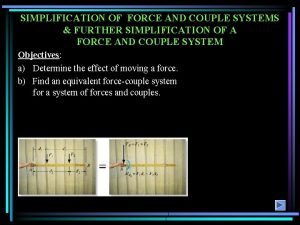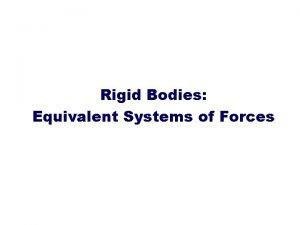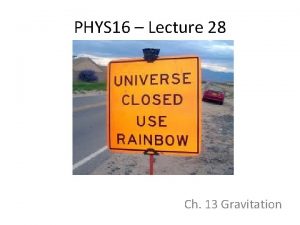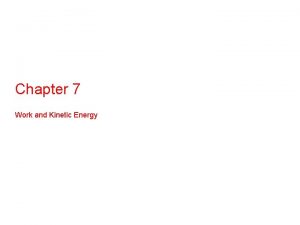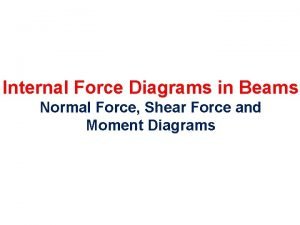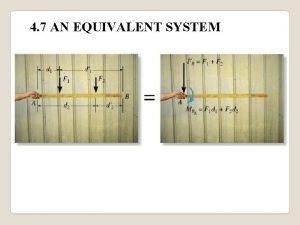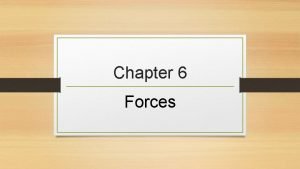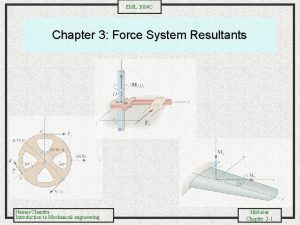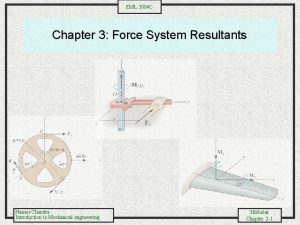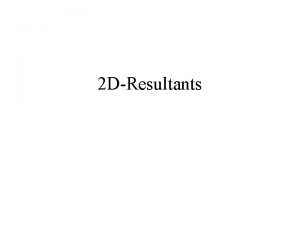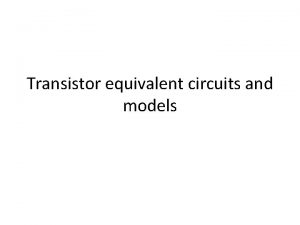EQUIVALENT SYSTEMS RESULTANTS OF FORCE AND COUPLE SYSTEM














- Slides: 14

EQUIVALENT SYSTEMS, RESULTANTS OF FORCE AND COUPLE SYSTEM, & FURTHER REDUCTION OF A FORCE AND COUPLE SYSTEM Today’s Objectives: Students will be able to: a) Determine the effect of moving a force. b) Find an equivalent force-couple system for a system of forces and couples. In-Class Activities: • Check Homework • Reading Quiz • Applications • Equivalent Systems • System Reduction • Concept Quiz • Group Problem Solving • Attention Quiz

APPLICATIONS What is the resultant effect on the person’s hand when the force is applied in four different ways ?

APPLICATIONS (continued) Several forces and a couple moment are acting on this vertical section of an I-beam. | | ? ? Can you replace them with just one force and one couple moment at point O that will have the same external effect? If yes, how will you do that?

AN EQUIVALENT SYSTEM (Section 4. 7) = When a number of forces and couple moments are acting on a body, it is easier to understand their overall effect on the body if they are combined into a single force and couple moment having the same external effect The two force and couple systems are called equivalent systems since they have the same external effect on the body.

MOVING A FORCE ON ITS LINE OF ACTION Moving a force from A to O, when both points are on the vectors’ line of action, does not change the external effect. Hence, a force vector is called a sliding vector. (But the internal effect of the force on the body does depend on where the force is applied).

MOVING A FORCE OFF OF ITS LINE OF ACTION Moving a force from point A to O (as shown above) requires creating an additional couple moment. Since this new couple moment is a “free” vector, it can be applied at any point P on the body.

RESULTANTS OF A FORCE AND COUPLE SYSTEM (Section 4. 8) When several forces and couple moments act on a body, you can move each force and its associated couple moment to a common point O. Now you can add all the forces and couple moments together and find one resultant force-couple moment pair.

RESULTANT OF A FORCE AND COUPLE SYSTEM (continued) If the force system lies in the x-y plane (the 2 -D case), then the reduced equivalent system can be obtained using the following three scalar equations.

FURTHER REDUCTION OF A FORCE AND COUPLE SYSTEM (Section 4. 9) = = If FR and MRO are perpendicular to each other, then the system can be further reduced to a single force, FR , by simply moving FR from O to P. In three special cases, concurrent, coplanar, and parallel systems of forces, the system can always be reduced to a single force.

EXAMPLE #1 Given: A 2 -D force and couple system as shown. Find: The equivalent resultant force and couple moment acting at A and then the equivalent single force location along the beam AB. Plan: 1) Sum all the x and y components of the forces to find FRA. 2) Find and sum all the moments resulting from moving each force to A. 3) Shift the FRA to a distance d such that d = MRA/FRy

EXAMPLE #1 (continued) + FRx = 25 + 35 sin 30° = 42. 5 lb FR + FRy = 20 + 35 cos 30° = 50. 31 lb + MRA = 35 cos 30° (2) + 20(6) – 25(3) = 105. 6 lb·ft FR = ( 42. 52 + 50. 312 )1/2 = 65. 9 lb = tan-1 ( 50. 31/42. 5) = 49. 8 ° The equivalent single force FR can be located on the beam AB at a distance d measured from A. d = MRA/FRy = 105. 6/50. 31 = 2. 10 ft.

EXAMPLE #2 o Given: The building slab has four columns. F 1 and F 2 = 0. Find: Plan: 1) Find FRO = Fi = FRzo k The equivalent resultant force and couple moment at the origin O. Also find the location (x, y) of the single equivalent resultant force. 2) Find MRO = (ri Fi) = MRx. O i + MRy. O j 3) The location of the single equivalent resultant force is given as x = -MRy. O/FRz. O and y = MRx. O/FRz. O

EXAMPLE #2 (continued) o FRO = {-50 k – 20 k} = {-70 k} k. N MRO = (10 i) (-20 k) + (4 i + 3 j)x(-50 k) = {200 j + 200 j – 150 i} k. N·m = {-150 i + 400 j } k. N·m The location of the single equivalent resultant force is given as, x = -MRyo/FRzo = -400/(-70) = 5. 71 m y = MRxo/FRzo = (-150)/(-70) = 2. 14 m

Group Problem Solving
 Force system resultants objectives
Force system resultants objectives Engineering mechanics moment of force problems
Engineering mechanics moment of force problems Equivalent force couple system example
Equivalent force couple system example Simplification of force and moment system
Simplification of force and moment system Force couple system
Force couple system Sum of moment
Sum of moment Rigid bodies equivalent systems of forces
Rigid bodies equivalent systems of forces Centripetal force and gravitational force
Centripetal force and gravitational force Hooke's law vector form
Hooke's law vector form Internal force
Internal force Decision support systems and intelligent systems
Decision support systems and intelligent systems Equivalent system
Equivalent system Is tension force contact or noncontact
Is tension force contact or noncontact Vt=2pir/t
Vt=2pir/t Long range force
Long range force



